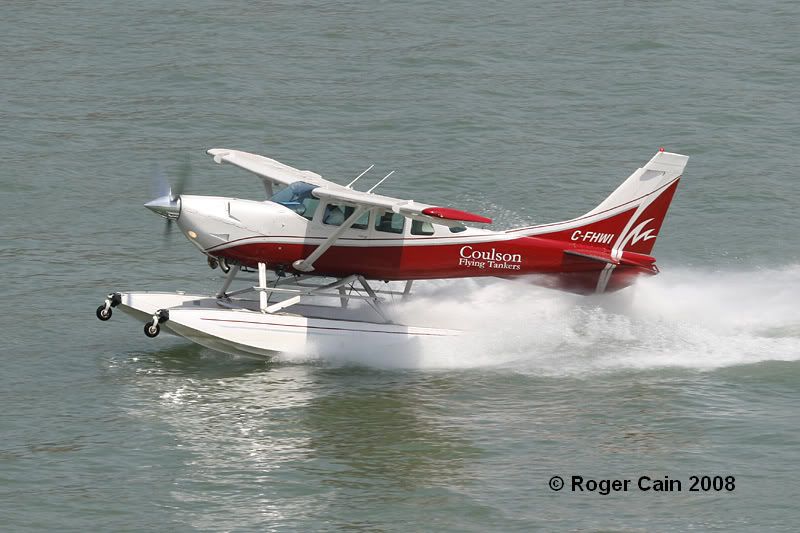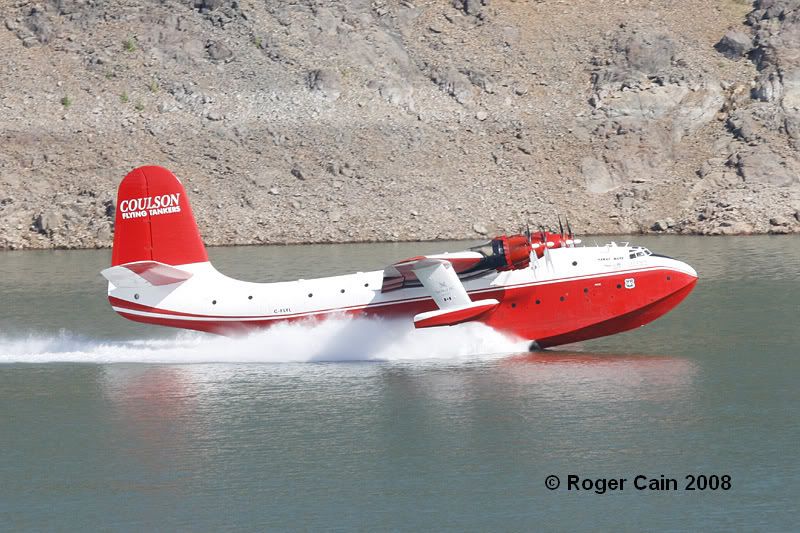Mon Jul 21, 2008 10:25 am
Great! The pick-up procedure and experience sounds like a interesting half minute! Thanks for sharing and welcome to the board!
Mon Jul 21, 2008 6:41 pm
Hey blackbird80k,
Thanks for an excellent insight into the Mars. I live in Vancouver and absolutely love seeing and hearing about them.
I look forward to hearing more about your experiences with the Mars.
Cheers,
David McIntosh
Thanks for an excellent insight into the Mars. I live in Vancouver and absolutely love seeing and hearing about them.
I look forward to hearing more about your experiences with the Mars.
Cheers,
David McIntosh
Mon Jul 21, 2008 6:49 pm
Thanks for the info.
So what kind of life do they get out of the engines?
And why 90 gallons of oil? Was that the standard installed tanks?
A C-97 with 4360's is I think 30 gallons.
So what kind of life do they get out of the engines?
And why 90 gallons of oil? Was that the standard installed tanks?
A C-97 with 4360's is I think 30 gallons.
Mon Jul 21, 2008 9:39 pm
Blackbird80k,
Thanks for the additional info.
Like Paul did, I made the 4+ hour drive up to Lake Shasta on July 5-6, to see this wonderful bird for myself. Along with the "Hawaii Mars" was their own Bird Dog (Cessna U206G) for spotting.


Thanks for the additional info.
Like Paul did, I made the 4+ hour drive up to Lake Shasta on July 5-6, to see this wonderful bird for myself. Along with the "Hawaii Mars" was their own Bird Dog (Cessna U206G) for spotting.


Martin Mars is coming to a nearby lake
Tue Jul 22, 2008 7:34 pm
Thanks to Blackbird and Roger for the info and pictures.The ASM guys from Alaska are here at the Medford Tanker Base and we've been watching the Mars and it's Bird Dog flying on the AFF (Automated Flight Following) and wondered about the configuration on the Cessna 206 and the weights on the Mars.Our questions have been answered.
Incidentally,I'll post some pictures on my Butler Aircraft thread fom a fire near Cave Junction,Oregon that I flew retardant to a couple of days ago.The ASM (Aerial Supervision Module) A-2 (a callsign indicating the 2nd leadplane pilot from the State of Alaska) took some video and captured a few frames of retardant drops.The ASM crew flies as a combination Leadplane and Air Attack Supervisor in the front and rear seats of a Pilatus PC-7.They primarily act as lead for ODF fires,but can also act as lead and/or air attack on Fed fires.
Incidentally,I'll post some pictures on my Butler Aircraft thread fom a fire near Cave Junction,Oregon that I flew retardant to a couple of days ago.The ASM (Aerial Supervision Module) A-2 (a callsign indicating the 2nd leadplane pilot from the State of Alaska) took some video and captured a few frames of retardant drops.The ASM crew flies as a combination Leadplane and Air Attack Supervisor in the front and rear seats of a Pilatus PC-7.They primarily act as lead for ODF fires,but can also act as lead and/or air attack on Fed fires.
Tue Jul 22, 2008 10:22 pm
Thanks Larry, been keeping an eye on your posts on the other tankers from Oregon. Very interesting and enjoyed. We saw #66 here on the local news over Santa Cruz last week.
Re: Just a bit about the JRM-3
Wed Jul 23, 2008 1:16 pm
blackbird80k wrote:As one of the very fortunate, remaining, few typed pilots on the Mars (and no, I'm not that old!) I just wanted to say a few things about the Old Ladies...The Wright 3350-24WA (all even number dash series of Wright engines being built for the US Navy aircraft) powerplants are not "derated" as described in the previous thread. They were built to produce 2500 HP from the 18 cylinder, two stage supercharger (the high boost stage locked out on the Mars). The 4 blade Curtis Wright (nepotism here don't ya think?) all steel propellors are controlled via the Curtis Electric propellor control system and a real gem once you understand the principals (took me weeks to get it right, and then I began teaching the system) Caroline Mars (one of the originals also purchased by the Forest Industries Flying Tankers consortium in 1959) was a P&W 4360 "corn cob" powered behemoth but converted to the 3350-24W and was lost in a freak tornado in Victoria BC in the early 60's prior to conversion as a water bomber.
On a water pickup, the 85,416 lb empty weight aircraft, carrying a crew of 4, fuel, foam, gel and approximately 90 gallons of oil behind each powerplant will weigh around 125, 000 lbs and scoop an additional 37,000 lbs of water for an all up gross of 162,000 lbs That's equivalent to a fully loaded 757 passenger aircraft! As fuel loads are burned and foam and gel is consumed, the aircraft can eventually pick up to 7200 gallons weighing 60,000 lbs for the true "big gulp"
The pick-up is conducted "On Step" at about 70 KIAS, as the touchdown occurs around 85 KIAS and the aircraft rapidly slows to 70 KIAS with the two water scoop probes selected down. As the giant slows, we are thrown forward against our shouldeer harness, and the Flight Engineer advances throttles to 54 in. Hg to maintain 70KIAS during the 28 seconds it takes to scoop 60,000 lbs of water.
Hope this is of interest to those of you reading. Cheers!
Welcome to WIX blackbird!
Its cool you fly the MARS. Amazing plane.
Video of Martin Mars July 2, 2008
Sun Jul 27, 2008 9:39 pm
Apologies for the poor camera work, not my forte. Sounds pretty cool, though. 
http://www.youtube.com/watch?v=PWjr19Br5QI
http://www.youtube.com/watch?v=PWjr19Br5QI
Re: Video of Martin Mars July 2, 2008
Sun Jul 27, 2008 10:12 pm
ZeamerB17 wrote:Apologies for the poor camera work, not my forte. Sounds pretty cool, though.
http://www.youtube.com/watch?v=PWjr19Br5QI
Yer right, awesome radial noise. It sounded like two passes though with only one aircraft in the video. Were both Mars there?
Re: Video of Martin Mars July 2, 2008
Sun Jul 27, 2008 10:28 pm
vernicator wrote:
Yer right, awesome radial noise. It sounded like two passes though with only one aircraft in the video. Were both Mars there?
No, only one Mars. A friend edited the vid for me; I don't know if he fiddled with the sound. Sounds funny in the middle there.
Mon Jul 28, 2008 8:19 pm
Welcome aboard Blackbird80k, especially since you're a flying boat guy.
Larry, I was wondering if you were back in action. Fly safe, friend.
Floats up (uh, never mind, Mars dont' do that)
Doug Ratchford, the "PBY guy" at Lone Star.
Larry, I was wondering if you were back in action. Fly safe, friend.
Floats up (uh, never mind, Mars dont' do that)
Doug Ratchford, the "PBY guy" at Lone Star.
Mon Jul 28, 2008 8:25 pm
I presume the Mars has returned home now?
Re: Just a bit about the JRM-3
Mon Jul 28, 2008 10:56 pm
blackbird80k wrote:As one of the very fortunate, remaining, few typed pilots on the Mars (and no, I'm not that old!) I just wanted to say a few things about the Old Ladies...The Wright 3350-24WA (all even number dash series of Wright engines being built for the US Navy aircraft) powerplants are not "derated" as described in the previous thread. They were built to produce 2500 HP from the 18 cylinder, two stage supercharger (the high boost stage locked out on the Mars). The 4 blade Curtis Wright (nepotism here don't ya think?) all steel propellors are controlled via the Curtis Electric propellor control system and a real gem once you understand the principals (took me weeks to get it right, and then I began teaching the system) Caroline Mars (one of the originals also purchased by the Forest Industries Flying Tankers consortium in 1959) was a P&W 4360 "corn cob" powered behemoth but converted to the 3350-24W and was lost in a freak tornado in Victoria BC in the early 60's prior to conversion as a water bomber.
On a water pickup, the 85,416 lb empty weight aircraft, carrying a crew of 4, fuel, foam, gel and approximately 90 gallons of oil behind each powerplant will weigh around 125, 000 lbs and scoop an additional 37,000 lbs of water for an all up gross of 162,000 lbs That's equivalent to a fully loaded 757 passenger aircraft! As fuel loads are burned and foam and gel is consumed, the aircraft can eventually pick up to 7200 gallons weighing 60,000 lbs for the true "big gulp"
The pick-up is conducted "On Step" at about 70 KIAS, as the touchdown occurs around 85 KIAS and the aircraft rapidly slows to 70 KIAS with the two water scoop probes selected down. As the giant slows, we are thrown forward against our shouldeer harness, and the Flight Engineer advances throttles to 54 in. Hg to maintain 70KIAS during the 28 seconds it takes to scoop 60,000 lbs of water.
Hope this is of interest to those of you reading. Cheers!
Thanks for the info and welcome to the board. You all wouldn't have a video of a water pick would you? Its not like you all are to busy scooping up a little H2O...
Lynn
Tue Jul 29, 2008 7:54 am
blackbird, check your Private Messages, please.
Gary
Gary
Tue Jul 29, 2008 2:45 pm
Roger Cain wrote:I presume the Mars has returned home now?
On a side note, Roger, nice cover photo of the F-6 for Pacific Flyers...
Lynn